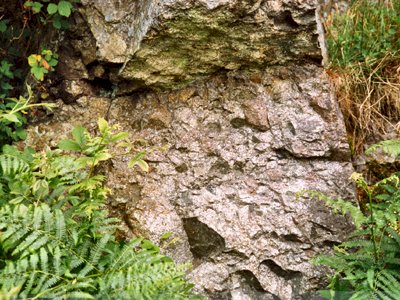Earth Science Conservation Review
| Slieve Gullion Ring - Glendesha Forest | Armagh |
| Site Type: | Scarp face |
| Site Status: | ASSI |
| Council area: | Newry & Mourne District Council |
| Grid Reference: | H995171 |
| Google maps: | 54.09389,-6.47922 |
| Rocks | |
|---|---|
| Rock Age: | Tertiary (Palaeogene) |
| Rock Name: | Porphyritic Felsite, Slieve Gullion Complex |
| Rock Type: | Agglomerate, Felsite, Granodiorite |
| Interest | |
| Other interest: | ring-dyke, volcanic vent, Contact, Intrusion |
Summary of site:
The context of this site is explained in the overview of the Slieve Gullion Ring complex, site 1118.
The forest now obscures the porphyritic felsite that forms the steep western flank of Slievebrack but it is still possible to see the southerly inclined flow structures that track the contact with the vent agglomerate at its base. The extreme explosive violence preceding the emplacement of the felsite is recorded by the agglomerate that consists mostly of the Newry granodiorite ripped from the wall of the ring during the cataclysmic degassing. The debris-filled vent was then invaded by the molten felsite.
This site, recording the early events in the formation of the ring dyke, is one of a suite of important sites which, taken together, show the evolution of the Slieve Gullion Ring complex. Sites of this kind should be regularly monitored to ensure that outcrops are clearly visible. Minimal felling and clearing should restore this exposure.
The forest now obscures the porphyritic felsite that forms the steep western flank of Slievebrack but it is still possible to see the southerly inclined flow structures that track the contact with the vent agglomerate at its base. The extreme explosive violence preceding the emplacement of the felsite is recorded by the agglomerate that consists mostly of the Newry granodiorite ripped from the wall of the ring during the cataclysmic degassing. The debris-filled vent was then invaded by the molten felsite.
This site, recording the early events in the formation of the ring dyke, is one of a suite of important sites which, taken together, show the evolution of the Slieve Gullion Ring complex. Sites of this kind should be regularly monitored to ensure that outcrops are clearly visible. Minimal felling and clearing should restore this exposure.
| Enlander, I., Dempster, M. & Doughty, P., 2025. Slieve Gullion Ring - Glendesha Forest, County Armagh, site summary. [In] Earth Science Conservation Review. https://www.habitas.org.uk/escr/summary.php?item=1124. Accessed on 2025-04-03 |
| Previous Site | Next Site |

